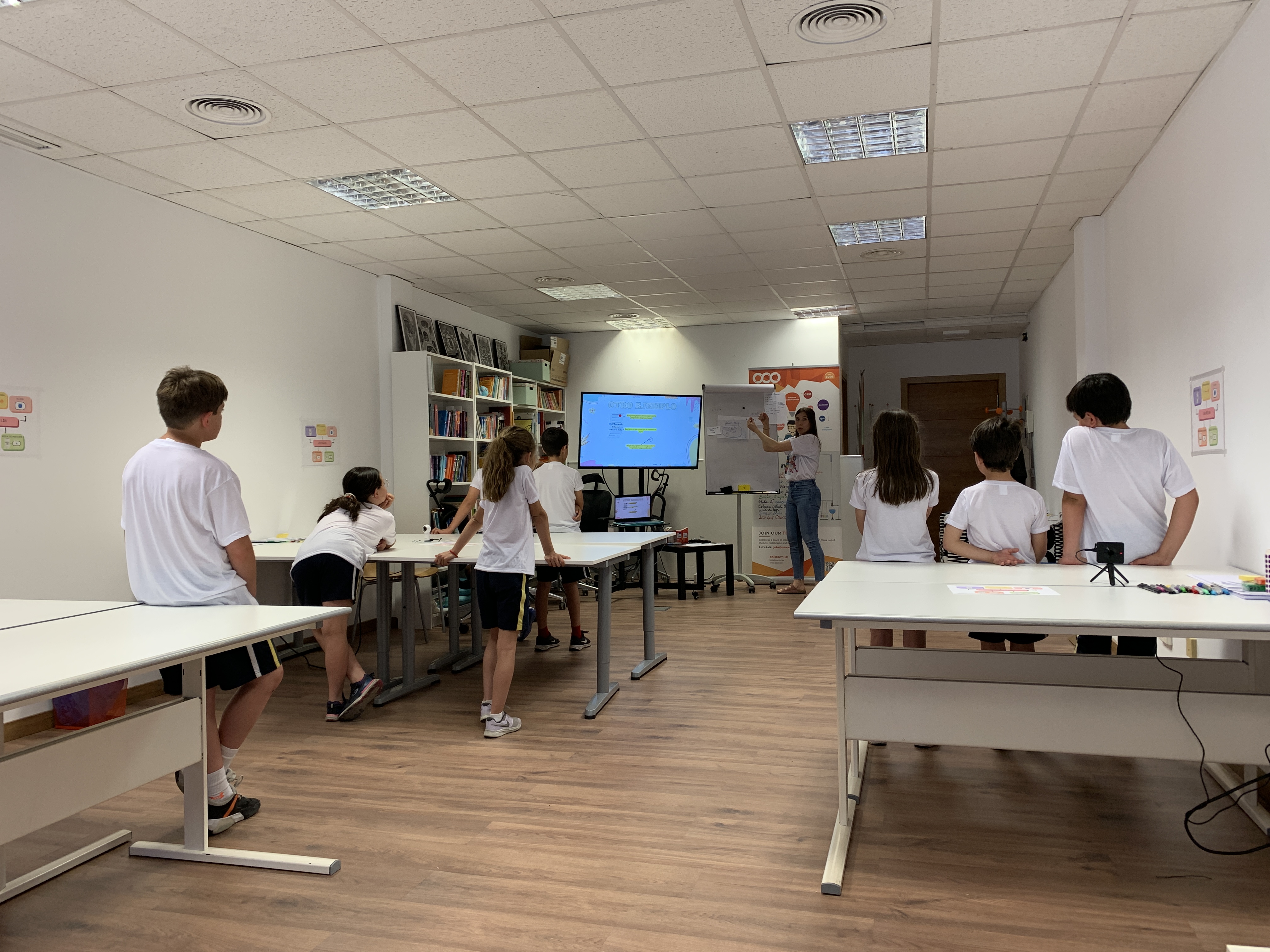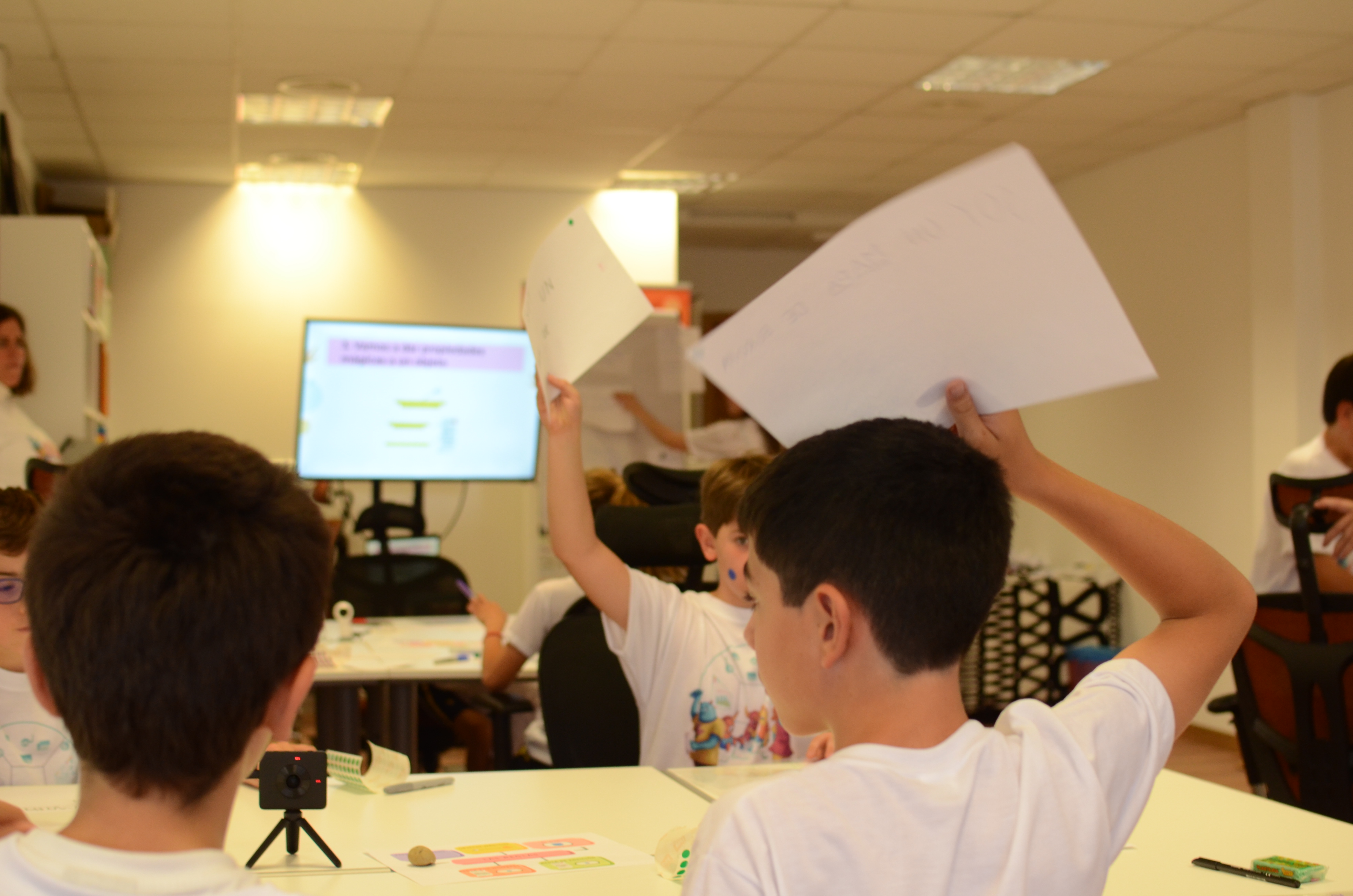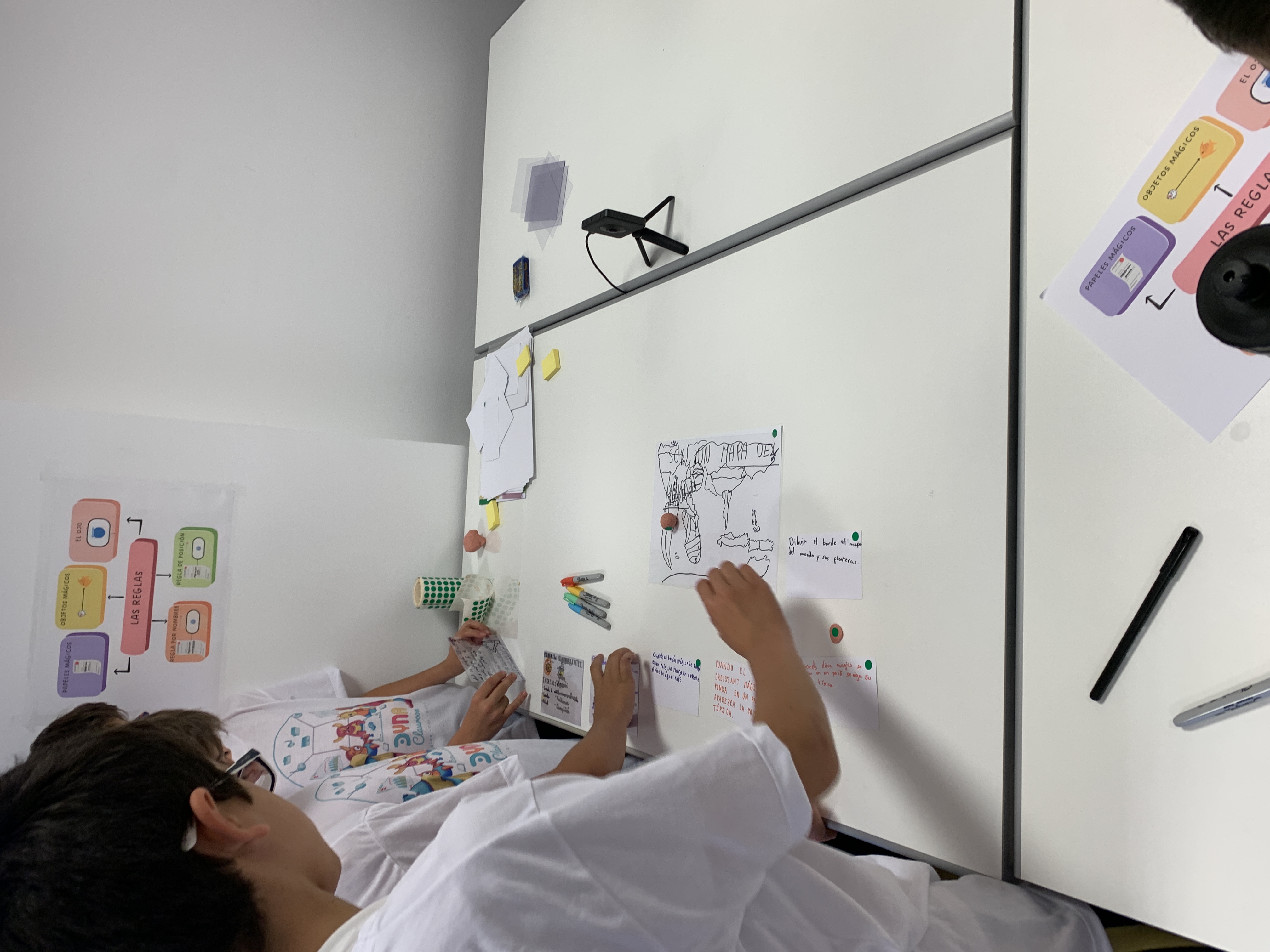At OSOCO, we are working on a new form of computational interaction called DynaClassroom, which allows people to collaborate with physical objects in the real world. Like any new technological and innovative creation, it takes time and iterations to reach different prototypes. Therefore, many ideas and hypotheses need to be validated before introducing any product to the market. Among the different design methods, we have already described in the previous post what participatory design is in theory, but this time we want to show you the practical case that has been carried out at the OSOCO offices: a participatory design workshop for the classroom of the future.

A group of children listening attentively to the workshop facilitator's explanations.
Education is currently facing a series of increasingly complex challenges 1. In a constantly evolving world marked by rapid technological advancements and profound social changes, educational systems around the world are forced to adapt to effectively prepare future generations 2. These current challenges in education span a wide range of areas, from equity and inclusion to educational technology, future workforce preparedness, and the development of relevant skills.
One of the most prominent challenges is the impact of technology on education. The rapid expansion of digital technologies has transformed the way we access information, communicate, and learn. However, the effective integration of technology in classrooms remains a challenge. Educators must learn to use digital tools meaningfully, fostering skills such as critical thinking, creativity, and problem-solving rather than simply replacing traditional teaching methods 3.
Furthermore, with automation and artificial intelligence rapidly transforming the job market, educational systems must adapt to develop the necessary skills in the 21st century 4 . This includes cognitive skills such as analytical thinking and adaptability, as well as socio-emotional skills such as collaboration and effective communication. Education should focus on cultivating lifelong learning and the ability to adapt to a constantly changing work environment.
Tip 1: Set goals before the workshop
Our main goal was to measure how children interact with the new medium, limited to a mock-up where technology does not yet come into play. We also wanted to validate a series of hypotheses about the interaction with the product, such as:
- Enhancing collaborative exploration of new ideas by the group.
- Promoting active participation as an amplifier of learning with methodologies like Constructivism.
- Measuring iconic and enactive thinking versus symbolic thinking.
- Motivating children to discover relationships between concepts and build their own propositions.
- Allowing the creation of not only static representations but also dynamic models of an idea through small simulations (“worlds”) to explore the functioning of things and draw their conclusions.
- In this medium, children learn better because they can answer their questions, search for answers on their own, consider different perspectives, exchange different viewpoints with other children, and add their findings to their existing understanding.
- Encouraging the representation of information from different perspectives.
- Orienting towards qualitative learning and the search for contrasts and different perspectives rather than absolute knowledge.
Tip 2: Gather participants in multiple workshops to iterate, define the workspace and the session agenda.
A total of 24 boys and girls between 8 and 12 years old participated in two three-hour workshops. Each workshop was structured with various interactive and dynamic activities designed to stimulate different areas of development. Teamwork, effective communication, and problem-solving were promoted using the DynaClassroom medium. These activities allowed children to learn how to collaborate, listen to and respect others’ ideas, strengthening their social and emotional skills.

A collection of groups of children participating in various activities during the participatory design workshop.
Tip 3: Include hands-on activities.
During each three-hour workshop, hands-on and artistic activities such as drawing and writing were carried out, allowing children to explore their imagination and communicate their ideas freely and creatively. A set of rules mimicking the coding of the real prototype was designed using only office materials. Despite initially thinking that the lack of technology would be limiting, a safe and stimulating learning environment was created, where participants felt motivated to explore and experiment with a new medium.

Three children collaborating during an activity.
These workshops represented an invaluable opportunity for the development of the future product, and while there is still much to be developed, the value of exploring the viability of a product with the bare minimum is emphasized.
For those interested in conducting a participatory design workshop with children, here are our lessons learned:
Do not underestimate the time: Working with children requires more time than expected, both in the preparation phase and during the workshop. It is essential to add a margin of time, approximately 10 minutes, to the allocated time for each activity. Additionally, it is important to leave free time slots between activities to allow flexibility and adapt to the rhythms and needs of the children. Proper time planning ensures a smoother experience and avoids stressful situations.
Maintain a friendly yet authoritative attitude: In a participatory design workshop with children, it is essential to establish a friendly and trusting relationship with the participants. As a facilitator, you should be an approachable figure to whom children can turn to express themselves and receive support. However, it is also important to maintain clear authority to maintain order and focus in the workshop. Setting clear boundaries and an effective disciplinary structure will help maintain a balance between a friendly atmosphere and achieving the workshop’s objectives.
Invent a mechanism to grab attention: Having effective strategies to capture children’s attention and smoothly transition between activities is essential. You can use visual signals, such as an eye-catching object or a specific gesture, to indicate to children that their attention is needed. You can also use storytelling techniques or quick games to focus and keep their active participation.
Increase the team: Compared to workshops with adults, participatory design workshops with children require a higher number of adults to ensure a safe and efficient experience. It is recommended to have at least one adult per five children to provide adequate supervision and individual attention. These additional adults can act as helpers or take on tasks such as note-taking and maintaining order.
Data collection: If you plan to use electronic equipment or devices such as cameras, it is important to take precautions to minimize interruptions and distractions during the workshop. Opt for smaller and discreet cameras and place them in inaccessible locations for children so they do not interfere with the workflow or distract their attention. Also, make sure to plan how the necessary data will be collected, whether through direct observation, written notes, or appropriate and secure audiovisual means.
In the next post, we will share the results of this workshop; we will explain the current state of DynaClassroom and provide recommendations for qualitative analysis.
This R&D project has received a financial grant from the Immersive Content, Metaverse, and Web3 Projects Call, organized by the Ministry of Economic Affairs and Digital Transformation, through the Secretary of State for Telecommunications and Digital Infrastructure.
References
- Hattie, J., & Yates, G. C. R. (2014). Visible Learning and the Science of How We Learn. Routledge. (This book provides an overview of the key challenges in education and explores effective teaching and learning strategies.) [return]
- Darling-Hammond, L., & Bransford, J. (Eds.). (2005). Preparing Teachers for a Changing World: What Teachers Should Learn and Be Able to Do. Jossey-Bass. (The book examines the challenges of teacher preparation and offers recommendations for improving teacher education programs.) [return]
- Fullan, M. (2016). The NEW Pedagogies of Deep Learning: Engage, Empower, Educate. Thousand Oaks, CA: Corwin. (This book discusses the need to shift education towards deeper learning and explores the challenges and strategies for implementing innovative teaching practices.) [return]
- Pellegrino, J. W., & Hilton, M. L. (Eds.). (2012). Education for Life and Work: Developing Transferable Knowledge and Skills in the 21st Century. National Academies Press. (The report highlights the challenges in developing 21st-century skills and offers recommendations for educational practices that foster transferable knowledge and skills.) [return]

